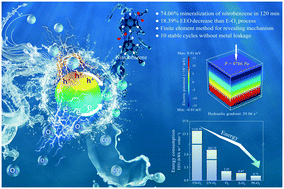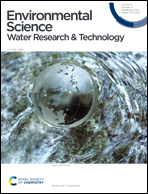Hydraulic-driven piezoelectric ozonation process for nitrobenzene degradation: synergy, energy consumption, impact factors, mechanism, and application potential†
Abstract
Although ozone coupling with electrolysis (E–O3) can increase the degradation of refractory organics due to effective generation of the hydroxyl radical (˙OH), its external power supply dependence and relatively high energy consumption restrict its application. Hence, a hydraulic-driven piezoelectric ozonation process (PE-O3) was proposed for nitrobenzene (NB) degradation. Notably, the synergy index of the PE-O3 process for NB degradation reached 3.98, while the mineralization ratio approached 85.23% in 120 min. The finite element method (FEM) revealed a positive correlation between the piezoelectric potential and the hydraulic gradient (G). A further study demonstrated that the gratifying degradation of NB was attributed to the massive production of ˙OH. Besides, various refractory organics could be effectively degraded in the PE-O3 process, while a satisfactory degradation of NB was observed in the actual water matrix. Moreover, the degradation of NB only decreased by 4.60% after 10 cycles of BaTiO3 without any metal ion leakage in the PE-O3 process. The energy consumption of the PE-O3 process for NB degradation was much lower than other ozone-based processes. This study may provide an efficient approach to the degradation of refractory organics by the potential utilization of residual hydraulic power in the water treatment and delivery process.



 Please wait while we load your content...
Please wait while we load your content...